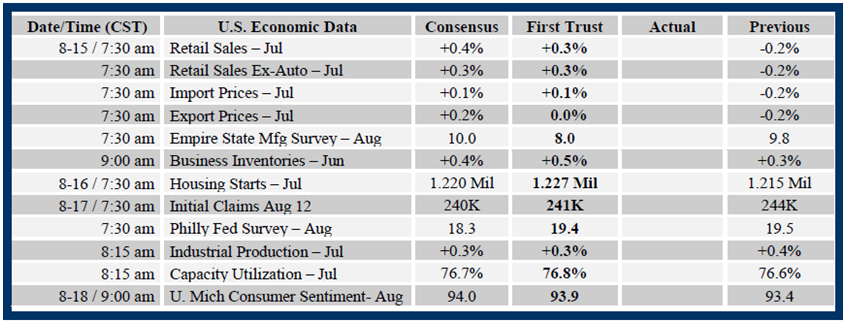Brian Wesbury Weekly Outlook
15.08.2017 13:34 - First Trust Global Portfolios Limited

Consumers are doing fine
It’s hard to read the business pages or watch the business news without seeing a story about the death of the consumer. In particular, the business press continues to be obsessed by relative weakness among traditional brick and mortar stores.
There’s no denying that the business model for delivering goods and services to consumers is changing fast. But that doesn’t mean the consumer, or retail in particular, is dead. Far from it.
Yes, in June, retail sales were up a tepid 2.8% from a year ago, 2.4% excluding auto sales. But the consensus view is that retail sales were up 0.4% in July. If so, retail sales, both overall and excluding autos, will be up about 3.5% from a year ago.
That’s right about what we’d expect given Plow Horse economic growth and an overall consumer price index that’s up 1.7% in the past year. Remember, goods prices have been rising more slowly than prices for services for the past several years in a row and retailers focus on selling goods.
Meanwhile, sales at non-store retailers, which include internet sales, have been growing at a 10% annual pace. That’s the key reason many brick and mortar stores have been taking it on the chin: not weak sales overall, but a shift toward those who can deliver the goods (literally) with the least fuss. Need to finally throw out those old pairs of underwear? Well, you can either get in a car and drive to the store to buy some new ones or take only a minute and go to a website that will deliver the same new ones to your door.
Also, many Americans are getting more value out of the items they buy. When your child outgrows a toy, you can put it on the Web and sell it, while those who don’t mind getting something used can buy it for less.
This week, many analysts will focus on the retail sales figures that come out of the Census Bureau each month, but figures from deep in the GDP reports show the consumer is doing fine.
For example, in the second quarter of 2017, total spending on motorcycles was up 9% from a year ago. Spending on boats used for personal pleasure was up 22%. Spending on pleasure aircraft was up 16%.
These are not the hallmarks of a consumer in the throes of death.
Yes, we are well aware that airplane ownership is not widespread. And, for most of the country, boat ownership isn’t either. So let’s look at some other kinds of spending as well. Spending on amusement parks and campgrounds was up 13% compared to a year ago. Meanwhile, Americans spent 11% more for veterinary services than a year ago.
Sorry, but Spot would not be getting better health care if Americans weren’t feeling pretty good.
None of this is to say that things couldn’t be much better. Of course they could! But the economy as a whole and the US consumer in particular keeps plowing forward despite tax rates, regulation, and government spending that are all too high.
Meanwhile, beneath the top line growth we do have, there’s a huge battle being fought between business models, old versus new. That’s not a sign of weakness, though. It’s a tribute to the entrepreneurial spirit that has made America great.
